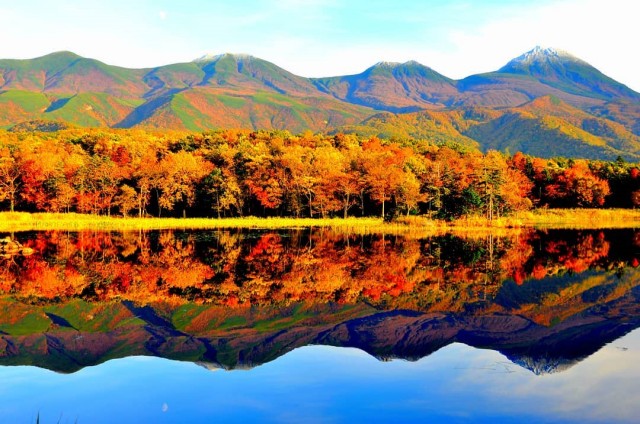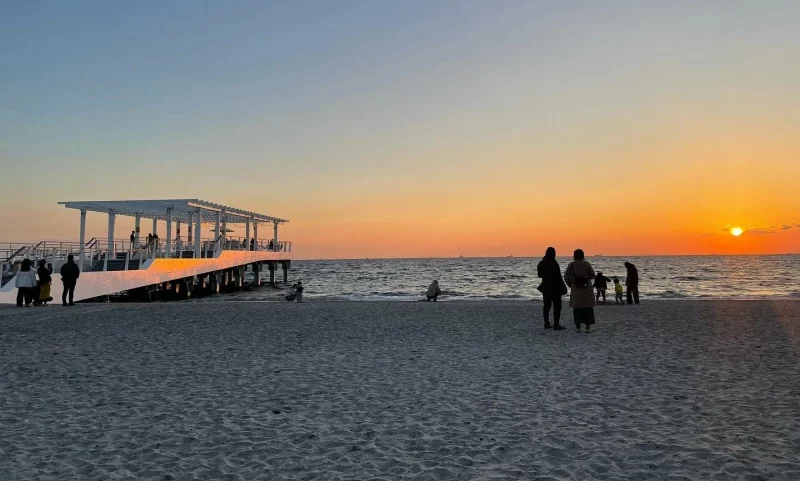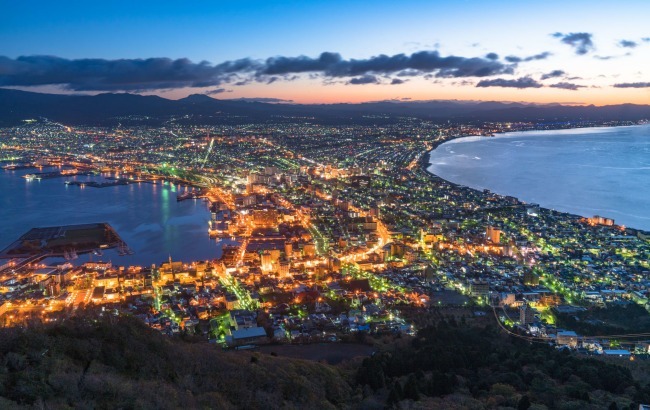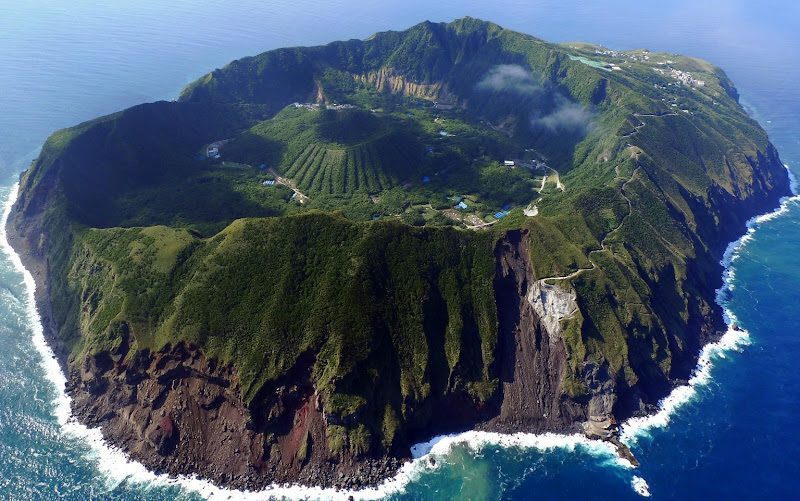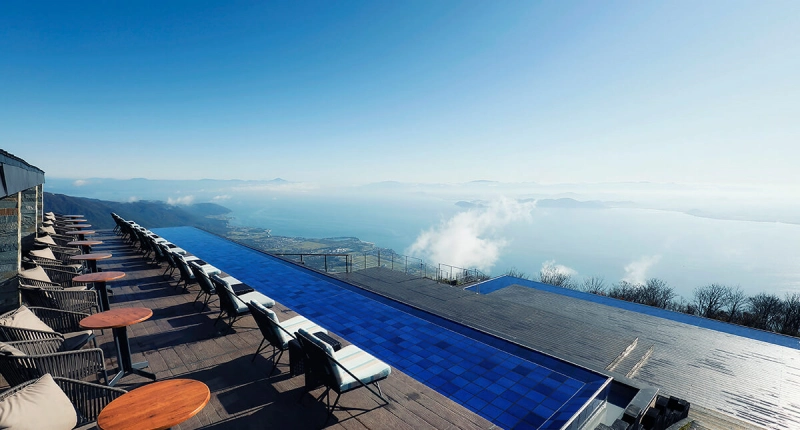"Being a popular destination known as the 'City in the Sea of Clouds,' Bitchu Matsuyama Castle, the vibrant orange-colored Avenue of Metasequoias in autumn, and the beautiful autumn foliage around Tanzan Shrine near the Thirteen-Story Pagoda are among the 21 recommended tourist spots for autumn travel in Western Japan today.
1. Bitchu Matsuyama Castle (備中松山城) (Okayama)
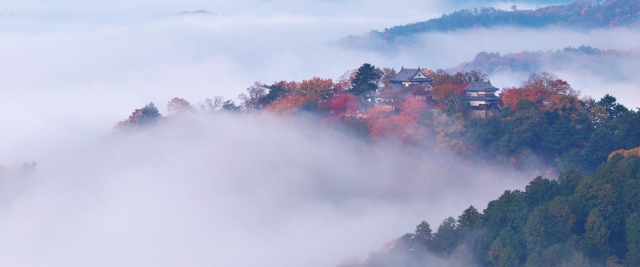
This is one of the only 12 surviving castle keeps in Japan, dating back to before the Edo period. Bitchu Matsuyama Castle is the smallest and highest-standing keep among them. It gained attention as the 'City in the Sea of Clouds,' as it was featured as the opening scene in the 2016 Taiga drama "Sanada Maru."
The sea of clouds typically occurs from late September to early April in the early morning until around 8 AM. The probability of occurrence is particularly high from late October to early December, making it the recommended season to visit for the sea of clouds.
- Bitchu Matsuyama Castle (備中松山城)
- Address: 1 Noyamashita, Takahashi City, Okayama Prefecture
- Official Website: http://www.city.takahashi.okayama.jp/soshiki/9/shiro4240131.html
2. Avenue of Metasequoias (メタセコイア並木) (Shiga)
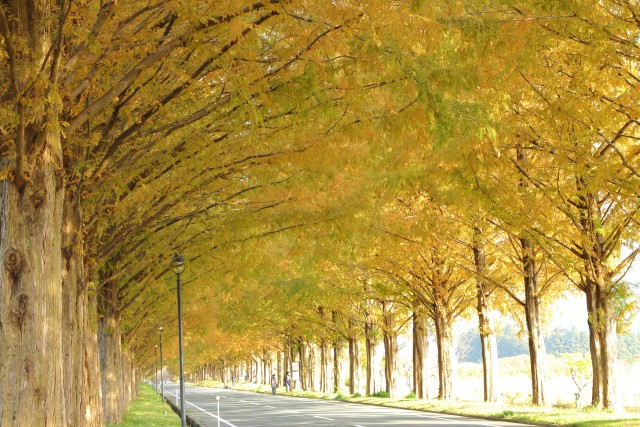
Along the road leading to Makino Highland, there are approximately 500 Metasequoia trees on both sides, spanning 2.4 kilometers. The refreshing and beautiful scenery is one of Japan's 'New Top 100 Roadside Trees.'
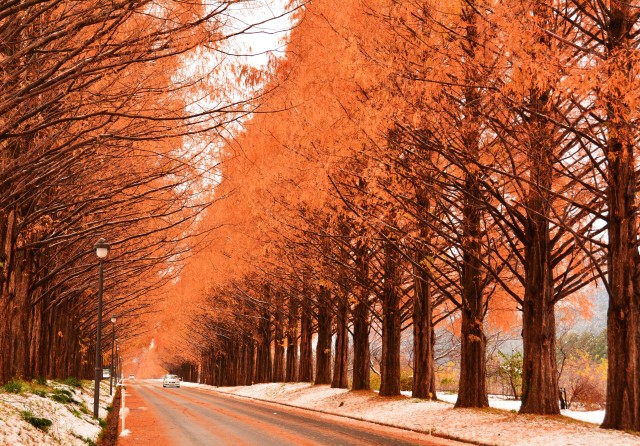
In autumn, the Metasequoia trees turn orange, especially vibrant in the morning sunlight. You can enjoy the Metasequoia red leaves from late November to early December every year.
- Avenue of Metasequoias (メタセコイア並木)
- Address: Makino-cho, Takashima City, Shiga Prefecture
Related Article: Shiga Prefecture's 15 Proudly Beautiful Spots! You Should See Them at Least Once
3. Tanzan Shrine (談山神社) (Nara)
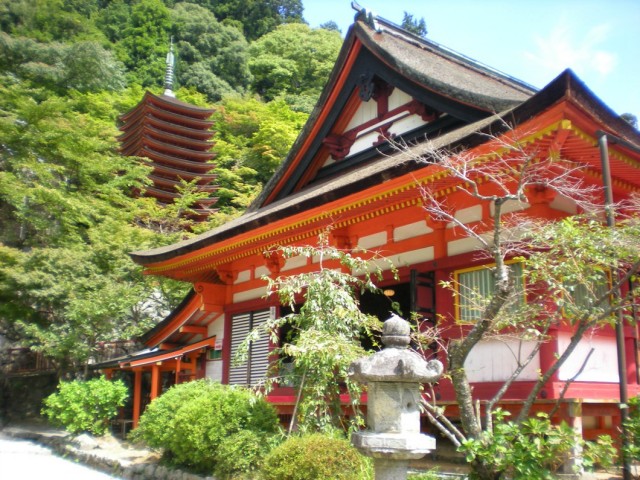
Tanzan Shrine is located on a mountain called Tabune on the outskirts of Sakurai City. It enshrines Fujiwara no Kamatari, who played a role in the Taika Reforms during the Asuka period. After his death, his eldest son, Sadaijin, built a thirteen-story pagoda, which is said to be the origin of Tanzan Shrine. Tanzan Shrine is also known as one of the 'Eight Shrines of the Yamato Shichi Fukuboku' pilgrimage, believed to bring good fortune and success.
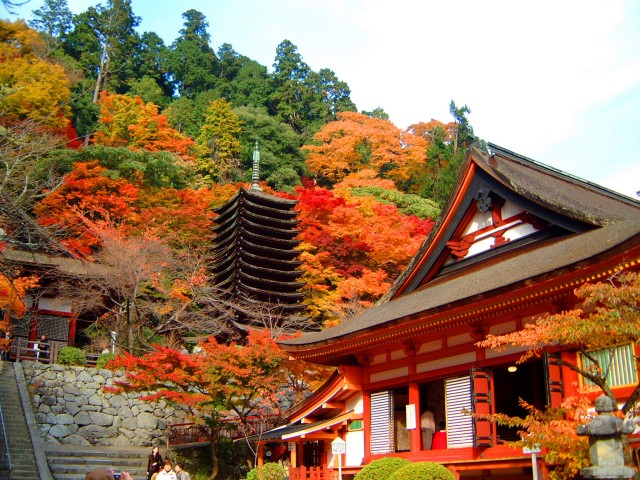
Additionally, it is famous for its autumn foliage. You can see blue maple leaves in spring and early summer, while in autumn, you can admire the red-colored maple leaves.
- Tanzan Shrine (談山神社)
- Address: 319 Tabune, Sakurai City, Nara Prefecture
- Official Website: http://www.tanzan.or.jp/
4. Izumo Ōyashiro (出雲大社) (Shimane)
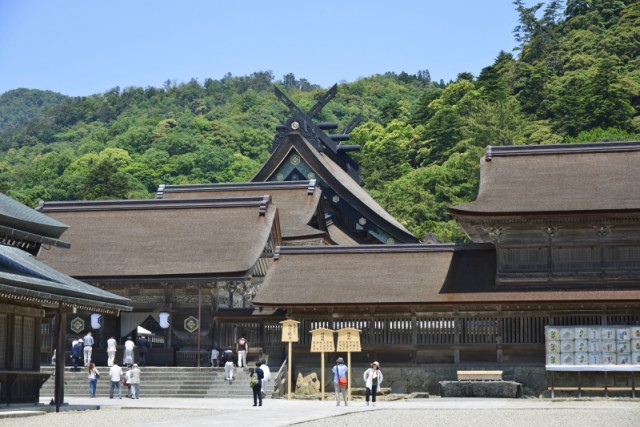
Izumo Ōyashiro is renowned as the Shrine of Marriage and Good Fortune. It is mentioned in Japan's oldest historical record, the "Kojiki," and has a long history. In the old calendar, the month of Kannazuki is when all the gods from around the country gather, with the date changing every year. According to the current calendar, Kannazuki corresponds to late October to early December, making it a recommended time to visit.
The enshrined deity here is "Okuninushi-no-kami," the god of marriage. It is believed that he governs not only relationships between men and women but all relationships in the world. The main shrine's grandeur is impressive, built in the oldest Japanese shrine architectural style known as "Taisha-zukuri." Izumo Taisha was designated as a national treasure in 1952.
- Izumo Ōyashiro (出雲大社)
- Address: 195 Taishacho Kizukihigashi, Izumo City, Shimane Prefecture
- Official Website: http://www.izumooyashiro.or.jp/
5. Ango-ji Temple (安国寺) (Hyogo)
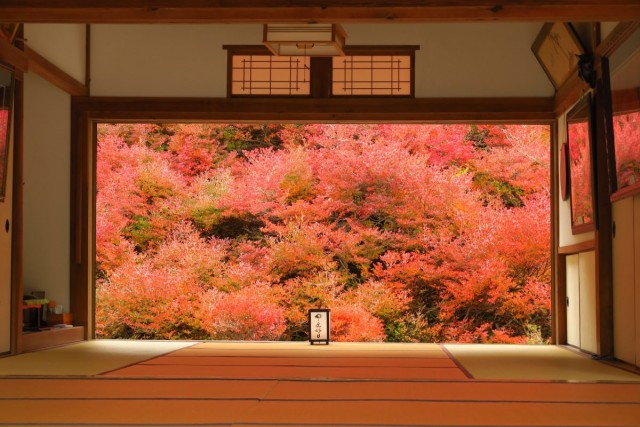
The azaleas in the backyard of Ango-ji Temple are famous. Normally a quiet temple nestled in the mountain village, it becomes a stunning sight during the autumn foliage season.
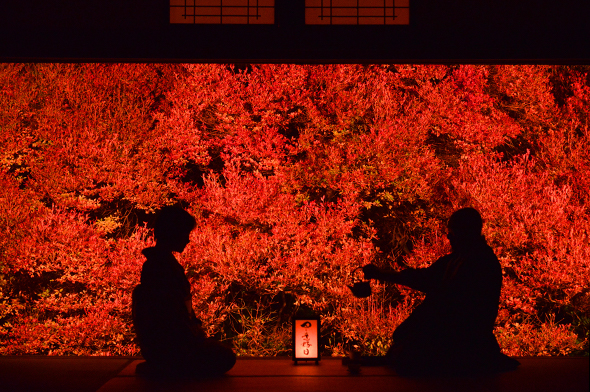
The best time to view the azaleas is around mid-November, and it is open to the public only during this period. Viewing the brilliant azaleas from the main hall is like looking at a beautiful painting framed in red.
- Ango-ji Temple (安国寺)
- Address: 327 Aida, Tantoyama-cho, Himeji City, Hyogo Prefecture
- Official Website: https://tantosilk.gr.jp/sightseeing_spot/doudantsutsuji/
6. Oishi Kogen (生石高原) (Wakayama)

The "Oishi Kogen" is located in the northern part of Wakayama Prefecture, part of the Nagamine Mountain Range extending east to west from Mount Koya to Minamiawaji City. The "Ikeda Plateau Prefectural Natural Park" spans Kumi-no-cho and Aridagawa-cho, centered around the 870-meter-high Ikeda Rock.
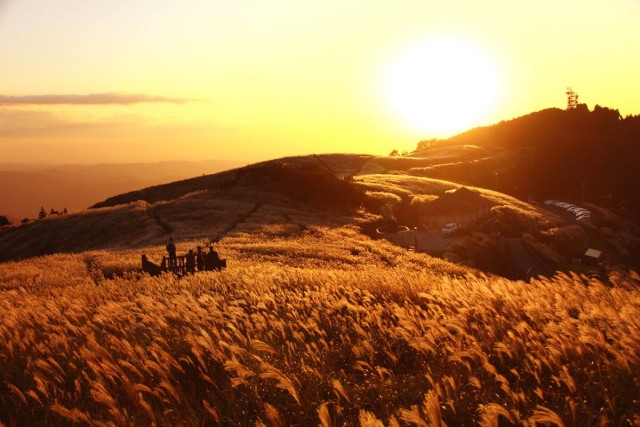
The Oishi Kogen is the top spot for susuki grass in Kansai, covering an area of about 13 square kilometers. The best viewing season for them is from early October to mid-November each year.
- Oishi Kogen (生石高原)
- Address: Ikeda, Aridagawa-cho, Aridagawa-gun, Wakayama Prefecture
- Official Website: https://www.wakayama-kanko.or.jp/spots/164/
7. Sogi Waterfall (曽木の滝) (Kagoshima)
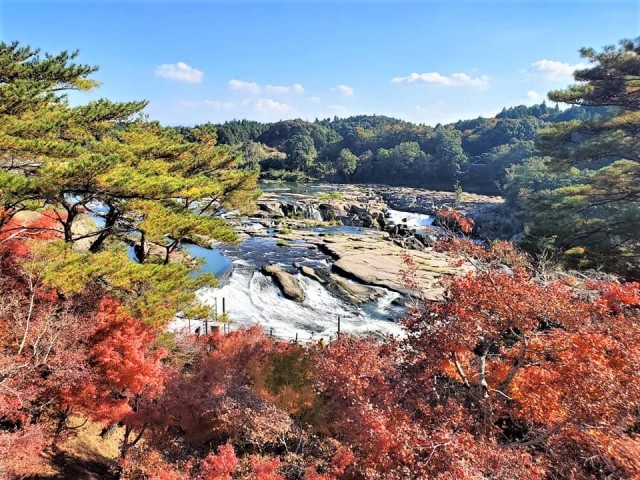
Sogi Waterfall, located in Isa City, is a large waterfall measuring 210 meters in width and 12 meters in height, often called the 'Niagara of the Orient.' In autumn, the surrounding maple and ginkgo trees take on vibrant colors, and there is also a nighttime light show during the viewing season.
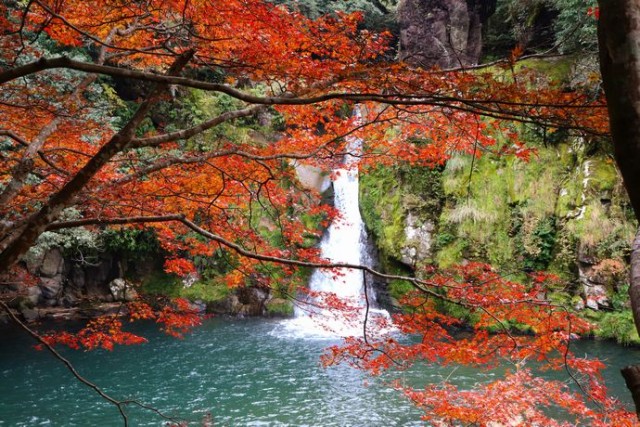
This area has been developed as a park, and there are dining places where you can enjoy traditional Isa cuisine like carp, rainbow trout, and eel before or after your walk.
- Sogi Waterfall (曽木の滝)
- Address: 628-41 Okonomiya, Isahaya, Kagoshima Prefecture
- Official Website: https://www.kagoshima-kankou.com/guide/10942
8. Awaji Hanasajiki (あわじ花さじき) (Hyogo)
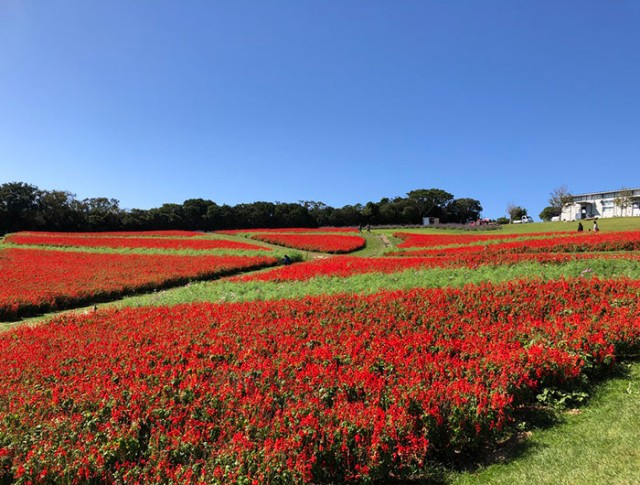
Awaji Hanasajiki is a famous flower viewing spot located in the northern highlands of Awaji Island. Admission is free. The facility also has a small observation deck that offers panoramic views of the flower fields with the Akashi Strait in the background. There is also a souvenir shop selling local products from Awaji Island.
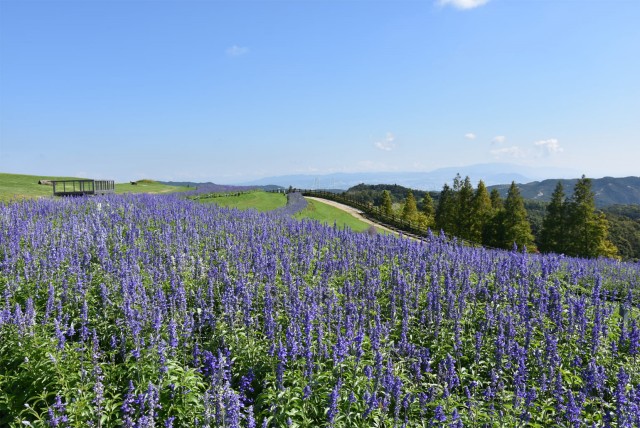
Flowers that bloom in autumn include blue plumbago (late August to late October) and red buckwheat flowers (early October to mid-October). In mid-October to early November, you can see large chrysanthemums.
- Awaji Hanasajiki (あわじ花さじき)
- Address: 2865-4 Kusamoto, Awaji City, Hyogo Prefecture
- Official Website: https://awajihanasajiki.jp/
9. Adachi Museum of Art (足立美術館) (Shimane)
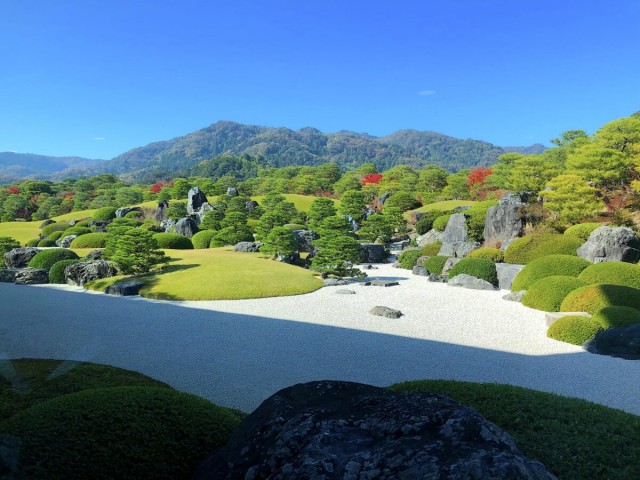
This is an art museum with a 50,000-square-meter Japanese garden. It consistently ranks first in the garden rankings of the American journal "Journal of Japanese Gardening" and has received a three-star rating in the "Michelin Green Guide Japan." With features like mountains and the sky as the background, the garden is like a landscape framed in a picture, offering a picturesque view.
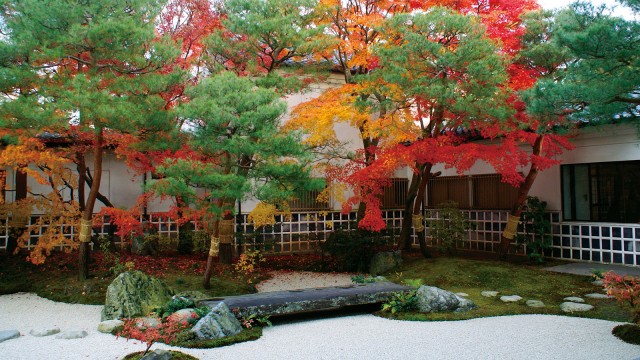
The Japanese garden has various areas, including a dry landscape garden, moss garden, and pond garden. In autumn, the red maple leaves add to the ambiance, making it even more splendid. Inside the museum, there is a place called "Sei-no-Gaku-e" where you can view the Japanese garden scenery through windows, resembling a painting.
The museum's collection includes about 130 works by Yokoyama Taikan, with approximately 20 of them on permanent display in the "Yokoyama Taikan Special Exhibition Room" on the second floor of the main building. Additionally, they collect and display modern Japanese paintings, ceramics by Kawakami Kozo, and children's drawings.
- Adachi Museum of Art (足立美術館)
- Address: 320 Furukawa-cho, Yasugi City, Shimane Prefecture
- Official Website: https://www.adachi-museum.or.jp/
10. Itsukushima Jinja Senjokaku Pavilion (千畳閣) (Hiroshima)
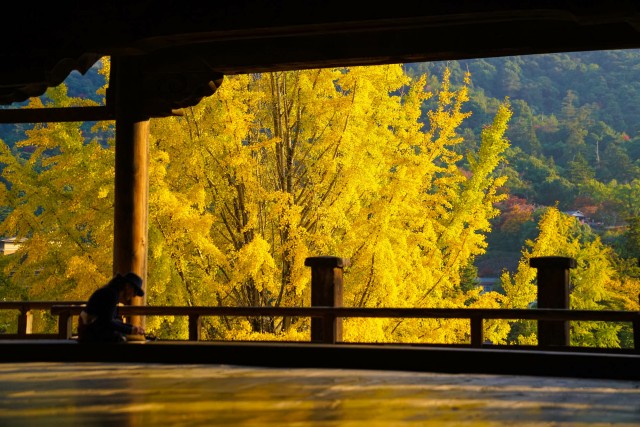
The main hall of Itsukushima Jinja Senjokaku Pavilion is called Senjo-kaku because it has 857 tatami mats, so it's known as "Senjo-kaku." It was built in the 15th year of Tensho (1587) under the command of Toyotomi Hideyoshi but remains unfinished to this day.
In autumn, the large ginkgo trees planted in front of Senjo-kaku turn yellow, and their reflections can be seen on the polished floor, creating a picturesque view.
- Itsukushima Jinja Senjokaku Pavilion (千畳閣)
- Address: 1-1 Miyajima-cho, Hatsukaichi City, Hiroshima Prefecture
- Official Website: https://www.miyajima.or.jp/sightseeing/ss_goju.html
11. Serakogen Farm (世羅高原農場) (Hiroshima)
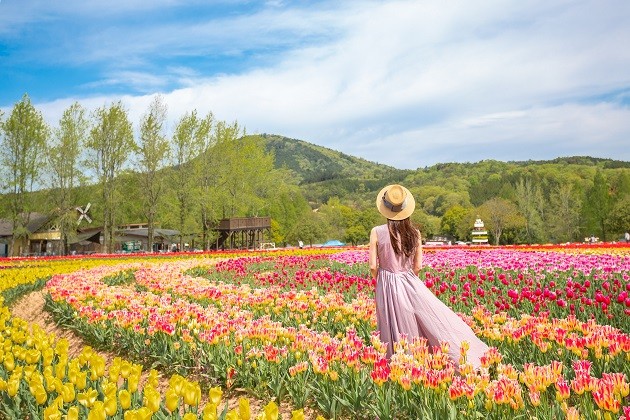
A farm where you can enjoy seasonal flower fields. In autumn, approximately 7,500 dahlias of around 550 varieties, the largest scale in Western Japan, bloom. The "Dahlia Festival" is held from early September to late October.
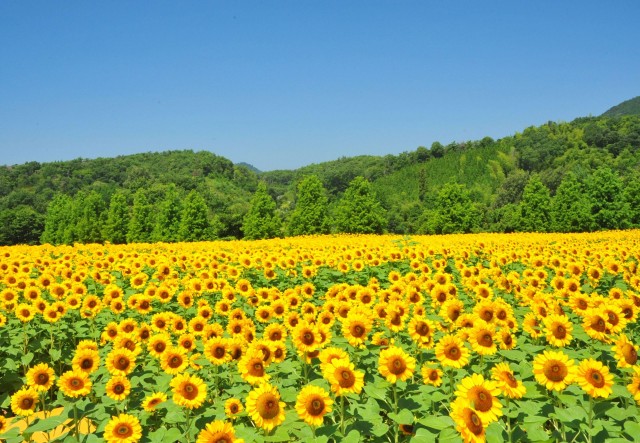
Although the farm is only open during various festivals, there is a farm restaurant where you can enjoy barbecues, as well as a flower cafe and shops, allowing you to leisurely spend time while taking a walk.
- Serakogen Farm (世羅高原農場)
- Address: 1124-11 Betsugawa, Sera-cho, Sera-gun, Hiroshima Prefecture
- Official Website: http://sera.ne.jp/
12. Genkō-an Temple (源光庵) (Kyoto)
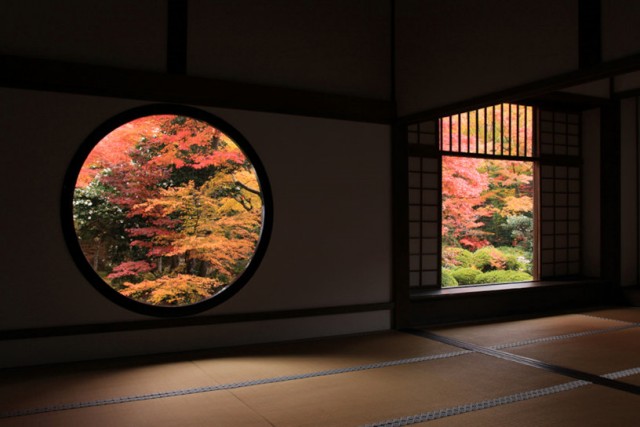
"Genkō-an" gained fame thanks to the JR Tokai poster saying, "Let's go to Kyoto." The temple has two windows known as "Windows of Enlightenment" and "Windows of Bewilderment" that convey Buddhist teachings.
Circular and square window frames serve as frames, and in autumn, you can enjoy red leaves that resemble Japanese paintings. The best time to view the red leaves is typically from mid-November to late November.
- Genkō-an Temple (源光庵)
- Address: 47 Kitayamafune-cho, Kita-ku, Kyoto City, Kyoto Prefecture
- Official Website: https://genkouan.or.jp/
13. Tottori Flower Park (とっとり花回廊) (Tottori)
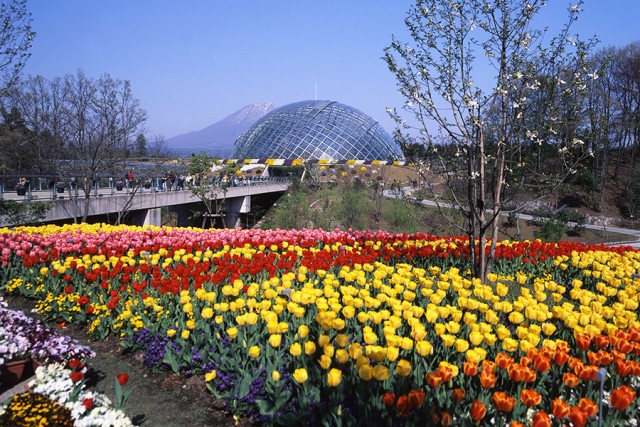
Japan's largest flower park with a total area of 50 square kilometers. Overlooking Tottori Prefecture's proud peaks, including Mount Daisen, the park features a massive glass greenhouse called the "Flower Dome," measuring 50 meters in diameter and 21 meters in height, as its centerpiece. Connected by corridors, you can enjoy gardens featuring various flowers from Japan to the West.

The main attraction is the vast "Flower Hill" covering an area of 10,000 square meters. In autumn, the bright red flowers of safflowers are a highlight of Tottori Hanakairo. We also recommend the large chrysanthemum field in the "Secret Garden" area.
- Tottori Flower Park (とっとり花回廊)
- Address: 110 Tsuruda, Minami-cho, Nishi-ku, Tottori City, Tottori Prefecture
- Official Website: http://www.tottorihanakairou.or.jp/
14. Former Chikurin-in Temple (旧竹林院) (Shiga)
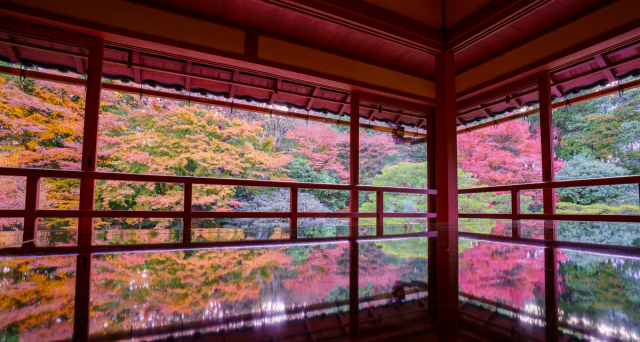
Located in Sakamoto, which prospered as the front town of Enryaku-ji Temple and is now one of the many "sato" (villages) within the temple grounds. Former Chikurin-in Temple is known for its 3,300-square-meter "kaiyu-shiki" (strolling garden) with a borrowed view of Hachioji-yama.
This garden is designated as a national scenic spot, and during the autumn season, there is illumination that is a must-see. You can also see the stunning scenery of red leaves reflecting on black tables. Enjoy a relaxing time while looking out at the garden and savoring matcha with sweets, if time allows.
- Former Chikurin-in Temple (旧竹林院)
- Address: 5-2-13 Sakamoto, Otsu City, Shiga Prefecture
- Official Website: http://kyuchikuriin.web.fc2.com/
15. Yasui Valley (安居渓谷) (Kochi)
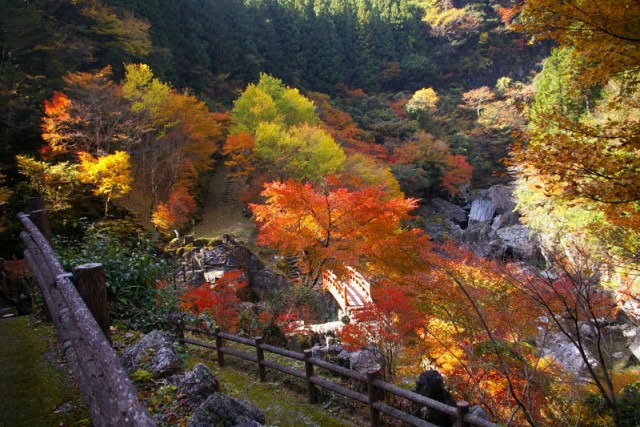
Famous as Kochi Prefecture's top spot for viewing autumn leaves, Yasui Valley is a valley that stretches along the Anokawa River in Niyodo Town, Kochi. Its symbol is the 40-meter-high "Hiryu Waterfall."
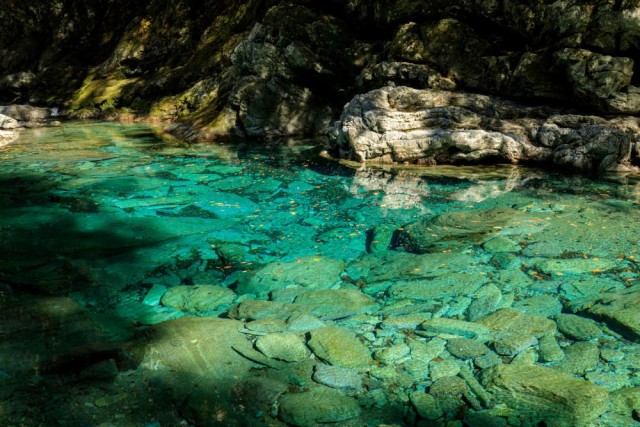
In the valley, you can also see the clearest "Niyodo Blue" water, known as "Crystal Pond." The crystal-clear water is breathtakingly beautiful.
- Yasui Valley (安居渓谷)
- Address: Oya, Niyodo Town, Agawa-gun, Kochi Prefecture
- Official Website: https://niyodoblue.jp/spot/detail.php?id=6
16. Sanuki Manno Park (国営讃岐まんのう公園) (Kagawa)

National Sanuki Manno Park is adjacent to Japan's largest reservoir, Mannou Pond, and is the only national park in Shikoku. The park covers 350 hectares (equivalent to 75 Tokyo Domes) and offers year-round flower displays. It allows people of all ages to get close to nature through activities, camping, and experience classrooms.
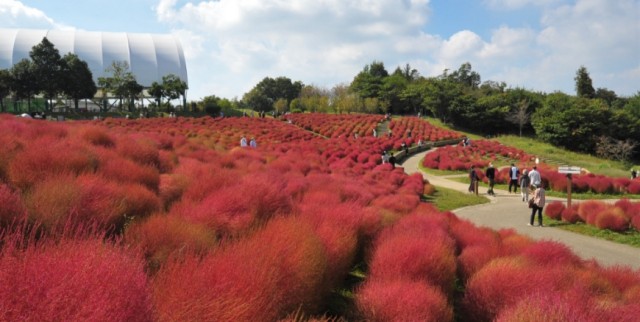
In autumn, large cosmos flowers, represented by red and yellow cosmos, bloom, adding color to the park.
- Sanuki Manno Park (国営讃岐まんのう公園)
- Address: 4243-12 Yoshino, Mannou-cho, Nakatado-gun, Kagawa Prefecture
- Official Website: https://sanukimannopark.jp/
17. Settsukyo Park (摂津峡公園) (Osaka)
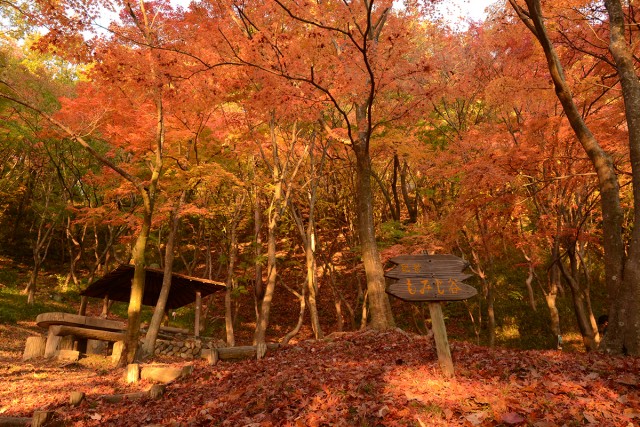
Settsukyo is a vast valley that runs through the upper and middle reaches of the Kegawa River in Takatsuki City, Osaka Prefecture. It is about 4 kilometers long. Features like Couple Rocks, Yasuoiwa Rocks, cliffs, and waterfalls along the way resemble the famous Yabakei landscape in Oita Prefecture, which is why it is called "Settsu Yabakei."
During November to December, you can enjoy spectacular autumn leaves, and many visitors come to see the red foliage.
- Settsukyo Park
- Address: 2-1 Momoyama-cho, Takatsuki City, Osaka Prefecture
- Official Website: https://www.takatsuki-kankou.org/settsukyo/
18. Chomonkyo (長門峡) (Yamaguchi)

Nagato Gorge is a vast valley stretching about 12 kilometers along the upper and middle reaches of the Abukawa River in Yamaguchi Prefecture. It is designated as a national scenic spot. Access is easy with the Nagato Gorge Station nearby. From the roadside station to the walking path along the gorge, it takes about 3 minutes on foot. Walking along the gorge while enjoying the scenery is a delightful experience.
The walking trail is 5.1 kilometers in total, and it takes approximately 100 minutes to complete the entire trail. During different periods such as the autumn leaf season and the Golden Week, shuttle buses run between the last stop on the walking trail, "Ryugu-an," and the station.
- Chomonkyo (長門峡)
- Address: Abuto/Hagi, Yamaguchi Prefecture
- Official Website: https://www.hagishi.com/search/detail.php?d=1100176
19. Mount Ishizuchi (石鎚山) (Ehime)
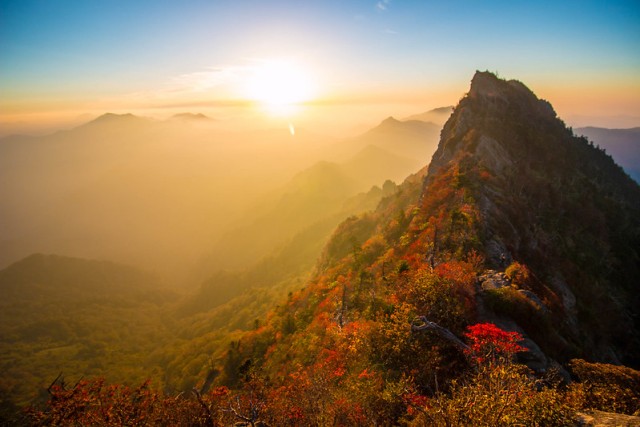
Mount Ishizuchi is the highest peak west of Kinki, with an elevation of 1,982 meters. There is a cable car that connects the station at the base of the mountain at an altitude of 455 meters with the summit station at an altitude of 1,300 meters. During the autumn leaf season, you can enjoy panoramic views of the red leaves from the cable car.
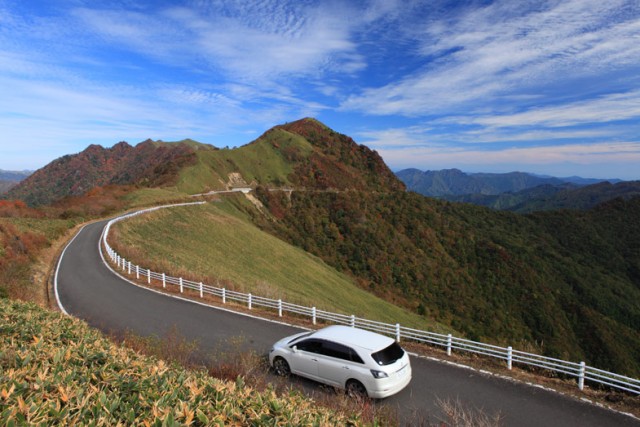
Along the way, you can also see the skyline of the mountainside. We recommend viewing the autumn leaves from vantage points like Face River Creek and Nagaozaka Observation Deck.
- Mount Ishizuchi (石鎚山)
- Address: Komatsu-cho, Saijo City, Ehime Prefecture, Ishizuchi Mountain
- Official Website: https://ishizuchisankei.com/spot/spot01/
20. Iya Valley (祖谷渓) (Saga)
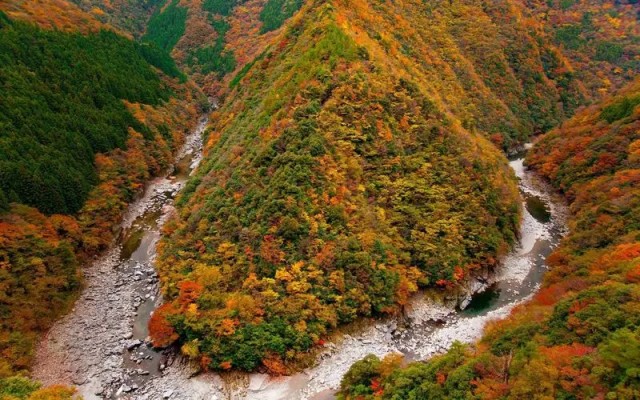
Iya Valley, located in the city of Miyoshi, Tokushima Prefecture, is a gorge stretching for about 10 kilometers. It is a deep V-shaped gorge where the elevation difference can reach over 100 meters depending on the location. Situated deep within the mountains of the Shikoku region, it features steep cliffs and precipices, giving it a dramatic appearance. Along the riverbanks, dense forests of trees extend all the way to the water's edge, and in autumn, the colors become vibrant.
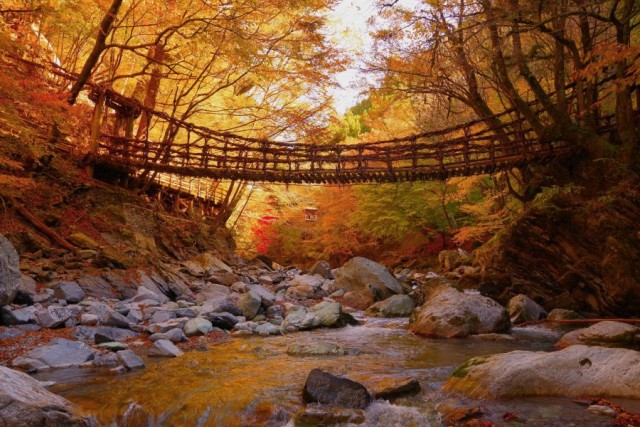
When it comes to Iya Valley, the most famous spot is the "Kazura Bridge of Zozu" (祖谷のかずら橋). However, during the autumn foliage season, we recommend visiting the "Double Kazura Bridge of Oku-Zozu" (奥祖谷二重かずら橋) deep in the mountains, which is about 20 kilometers from Vine Bridge. The journey takes approximately one hour by car. Here, you can experience an exhilarating suspension bridge adventure amidst the fiery red maple leaves.
- Iya Valley (祖谷渓)
- Address: Matsuo, Ikeda-cho, Miyoshi City, Tokushima Prefecture, Nishi Zozuyama Village
- Official Website: https://ishizuchisankei.com/spot/spot01/
21. Mifuneyama Rakuen (御船山楽園) (Saga)
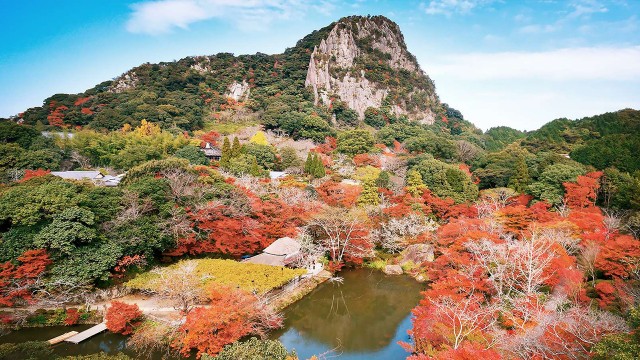
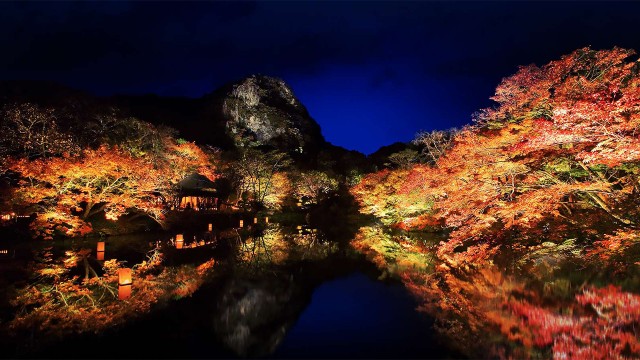
Mifuneyama Rakuen (御船山楽園), located in Takeo, Saga Prefecture, is a pond and stream garden created by Lord Takeo Nabeshima during the Edo period. This exquisite garden was constructed over three years with the assistance of Kano school painters invited from Kyoto. In the autumn season, the garden hosts the "Momiji Festival" where maple trees, leading the seasonal transformation, are illuminated to create a stunning display of red leaves. The garden encompasses approximately 40,000 square meters of land and is also renowned for hosting Japan's largest-scale red leaf illumination event.
- Mifuneyama Rakuen (御船山楽園)
- Address: 4100 Takeo-cho, Takeo City, Saga Prefecture, Japan
- Official Website: http://www.mifuneyamarakuen.jp/
